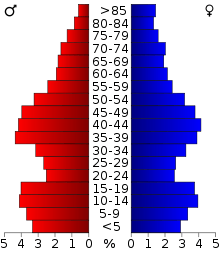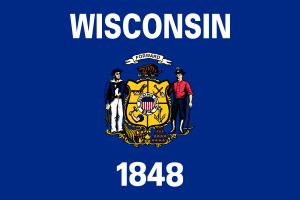Chippewa County, Wisconsin
Chippewa County is a county located in the U.S. state of Wisconsin. It is named for the historic Chippewa people, also known as the Ojibwe, who long controlled this territory. As of the 2010 census, the population was 62,415.[1] Its county seat is Chippewa Falls.[2] The county was founded in 1845 from Crawford County,[3] then in the Wisconsin Territory, and organized in 1853.[4][5][6]
Chippewa County | |
|---|---|
Chippewa County Courthouse, February 2015 | |
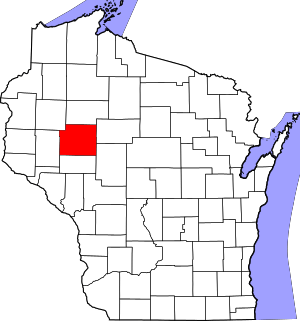 Location within the U.S. state of Wisconsin | |
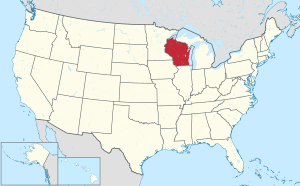 Wisconsin's location within the U.S. | |
| Coordinates: 45°04′N 91°17′W | |
| Country | |
| State | |
| Founded | 1853 |
| Named for | Ojibwa |
| Seat | Chippewa Falls |
| Largest city | Chippewa Falls |
| Area | |
| • Total | 1,041 sq mi (2,700 km2) |
| • Land | 1,008 sq mi (2,610 km2) |
| • Water | 33 sq mi (90 km2) 3.2% |
| Population (2010) | |
| • Total | 62,415 |
| • Estimate (2019) | 64,658 |
| • Density | 60/sq mi (23/km2) |
| Time zone | UTC−6 (Central) |
| • Summer (DST) | UTC−5 (CDT) |
| Congressional districts | 3rd, 7th |
| Website | www |
Chippewa County is included in the Eau Claire, WI Metropolitan Statistical Area as well as the Eau Claire-Menomonie, WI Combined Statistical Area.
Geography
According to the U.S. Census Bureau, the county has a total area of 1,041 square miles (2,700 km2), of which 1,008 square miles (2,610 km2) is land and 33 square miles (85 km2) (3.2%) is water.[7]
Adjacent counties
- Rusk County – north
- Taylor County – east
- Clark County – southeast
- Eau Claire County – south
- Dunn County – west
- Barron County – northwest
Major highways
|
|
Airports
- KEAU - Chippewa Valley Regional Airport
- 4WI9 - Cornell Municipal Airport
Demographics
| Historical population | |||
|---|---|---|---|
| Census | Pop. | %± | |
| 1850 | 615 | — | |
| 1860 | 1,895 | 208.1% | |
| 1870 | 8,311 | 338.6% | |
| 1880 | 15,491 | 86.4% | |
| 1890 | 25,143 | 62.3% | |
| 1900 | 33,037 | 31.4% | |
| 1910 | 32,103 | −2.8% | |
| 1920 | 36,482 | 13.6% | |
| 1930 | 37,342 | 2.4% | |
| 1940 | 40,703 | 9.0% | |
| 1950 | 42,839 | 5.2% | |
| 1960 | 45,096 | 5.3% | |
| 1970 | 47,717 | 5.8% | |
| 1980 | 52,127 | 9.2% | |
| 1990 | 52,360 | 0.4% | |
| 2000 | 55,195 | 5.4% | |
| 2010 | 62,415 | 13.1% | |
| Est. 2019 | 64,658 | [8] | 3.6% |
| U.S. Decennial Census[9] 1790–1960[10] 1900–1990[11] 1990–2000[12] 2010–2019[1] | |||
As of the census[13] of 2000, there were 55,195 people, 21,356 households, and 15,013 families residing in the county. The population density was 55 people per square mile (21/km²). There were 22,821 housing units at an average density of 23 per square mile (9/km²). The racial makeup of the county was 97.85% White, 0.16% Black or African American, 0.32% Native American, 0.89% Asian, 0.01% Pacific Islander, 0.17% from other races, and 0.60% from two or more races. 0.52% of the population were Hispanic or Latino of any race. 44.1% were of German, 15.8% Norwegian and 5.8% Irish ancestry.
There were 21,356 households out of which 33.70% had children under the age of 18 living with them, 58.30% were married couples living together, 8.00% had a female householder with no husband present, and 29.70% were non-families. 24.70% of all households were made up of individuals and 11.00% had someone living alone who was 65 years of age or older. The average household size was 2.53 and the average family size was 3.03.
In the county, the population was spread out with 26.50% under the age of 18, 7.70% from 18 to 24, 28.20% from 25 to 44, 23.10% from 45 to 64, and 14.60% who were 65 years of age or older. The median age was 38 years. For every 100 females, there were 99.10 males. For every 100 females age 18 and over, there were 96.00 males.
In 2017, there were 624 births, giving a general fertility rate of 59.7 births per 1000 women aged 15–44, the 26th lowest rate out of all 72 Wisconsin counties.[14] Additionally, there were fewer than five reported induced abortions performed on women of Chippewa County residence in 2017.[15]
Economy
The largest employers in Chippewa County are:[16]
| 1 | TTM Advanced Circuits |
| 2 | Chippewa Falls Public Schools |
| 3 | Saint Joseph's Hospital |
| 4 | Wisconsin Department of Corrections |
| 5 | Wal-Mart |
| 6 | Mason Companies Inc |
| 7 | Chippewa County |
| 8 | Mayo Health System |
| 9 | Silicon Graphics International |
| 10 | Cooperative Educational Service Agency #10 |
Library
The University of Wisconsin-Eau Claire's Special Collections and Archives, located on the fifth floor of McIntyre Library, houses an extensive collection of public records, books and collections relating to Chippewa County. In addition to vital records (birth and marriage) dating to 1907, there are also naturalization records, census records, and civil and circuit court records. These resources are very popular with local genealogists.
Within the local history collection, there are books about immigration to the region, logging, church and cemetery records, reminiscences by local residents, and a number of histories and biographies compiled by local historians.
Special Collections and Archives also houses numerous archives files which relate to Chippewa County. There are many collections which pertain to logging, the railway industry and agriculture.
The University of Wisconsin-Eau Claire's Special Collections and Archives also includes information for Buffalo, Clark, Eau Claire, Rusk and Taylor counties.
Communities
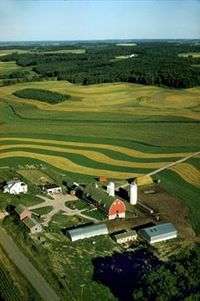
Cities
- Bloomer
- Chippewa Falls (county seat)
- Cornell
- Eau Claire (mostly in Eau Claire County)
- Stanley (partly in Clark County)
Villages
- Boyd
- Cadott
- Lake Hallie
- New Auburn (partly in Barron County)
Towns
Census-designated places
Other unincorporated communities
Politics
| Year | Republican | Democratic | Third parties |
|---|---|---|---|
| 2016 | 56.8% 17,916 | 37.7% 11,887 | 5.6% 1,765 |
| 2012 | 49.5% 15,322 | 49.3% 15,237 | 1.2% 373 |
| 2008 | 44.6% 13,492 | 53.7% 16,239 | 1.7% 500 |
| 2004 | 50.6% 15,450 | 48.3% 14,751 | 1.1% 323 |
| 2000 | 49.0% 12,835 | 46.2% 12,102 | 4.7% 1,236 |
| 1996 | 35.6% 7,520 | 45.7% 9,647 | 18.8% 3,964 |
| 1992 | 32.6% 8,215 | 41.6% 10,487 | 25.9% 6,528 |
| 1988 | 45.7% 9,757 | 53.6% 11,447 | 0.7% 150 |
| 1984 | 51.5% 10,986 | 47.8% 10,202 | 0.8% 163 |
| 1980 | 48.1% 10,531 | 44.9% 9,836 | 7.1% 1,545 |
| 1976 | 40.5% 8,137 | 57.4% 11,538 | 2.1% 418 |
| 1972 | 49.4% 8,451 | 48.0% 8,210 | 2.7% 462 |
| 1968 | 47.4% 7,772 | 44.7% 7,335 | 7.9% 1,296 |
| 1964 | 36.5% 6,277 | 63.4% 10,911 | 0.2% 26 |
| 1960 | 47.0% 8,690 | 52.9% 9,793 | 0.2% 28 |
| 1956 | 59.4% 9,781 | 40.2% 6,617 | 0.4% 63 |
| 1952 | 64.0% 11,429 | 35.7% 6,380 | 0.3% 45 |
| 1948 | 43.6% 6,146 | 54.6% 7,702 | 1.8% 254 |
| 1944 | 53.6% 7,691 | 45.8% 6,567 | 0.7% 93 |
| 1940 | 54.3% 8,781 | 44.8% 7,250 | 0.9% 140 |
| 1936 | 38.9% 5,760 | 53.1% 7,854 | 8.0% 1,182 |
| 1932 | 35.7% 4,792 | 62.9% 8,445 | 1.4% 184 |
| 1928 | 55.4% 7,514 | 44.1% 5,985 | 0.5% 62 |
| 1924 | 41.7% 5,135 | 4.6% 560 | 53.7% 6,613 |
| 1920 | 82.6% 6,750 | 13.5% 1,103 | 3.9% 322 |
| 1916 | 58.2% 3,324 | 39.1% 2,233 | 2.8% 159 |
| 1912 | 33.9% 1,736 | 39.6% 2,028 | 26.4% 1,353 |
| 1908 | 59.1% 3,526 | 36.9% 2,203 | 4.0% 240 |
| 1904 | 66.5% 3,744 | 29.7% 1,670 | 3.9% 217 |
| 1900 | 61.9% 4,215 | 35.9% 2,446 | 2.2% 151 |
| 1896 | 54.1% 3,601 | 44.0% 2,929 | 1.9% 127 |
| 1892 | 39.5% 1,975 | 50.6% 2,530 | 10.0% 498 |
References
- "State & County QuickFacts". United States Census Bureau. Archived from the original on July 8, 2011. Retrieved January 18, 2014.
- "Find a County". National Association of Counties. Archived from the original on May 9, 2015. Retrieved June 7, 2011.
- "Early Settlement of West-Central Wisconsin" (PDF). University of Wisconsin-Eau Claire McIntyre Library Special Collections. Archived from the original (PDF) on August 23, 2016. Retrieved November 28, 2016.
- Taken from Wisconsin Blue Book 1991-1992 p. 731; cited there as from "Wisconsin Historical Records, Origin and Legislative History of County Boundaries in Wisconsin, 1942."
- When Counties Originated from rootsweb.com's Oconto County, Wisconsin webpage Archived March 29, 2007, at the Wayback Machine.
- "Wisconsin: Individual County Chronologies". Wisconsin Atlas of Historical County Boundaries. The Newberry Library. 2007. Retrieved August 13, 2015.
- "2010 Census Gazetteer Files". United States Census Bureau. August 22, 2012. Retrieved August 2, 2015.
- "Population and Housing Unit Estimates". Retrieved March 26, 2020.
- "U.S. Decennial Census". United States Census Bureau. Retrieved August 2, 2015.
- "Historical Census Browser". University of Virginia Library. Retrieved August 2, 2015.
- Forstall, Richard L., ed. (March 27, 1995). "Population of Counties by Decennial Census: 1900 to 1990". United States Census Bureau. Retrieved August 2, 2015.
- "Census 2000 PHC-T-4. Ranking Tables for Counties: 1990 and 2000" (PDF). United States Census Bureau. April 2, 2001. Retrieved August 2, 2015.
- "U.S. Census website". United States Census Bureau. Retrieved May 14, 2011.
- "Annual Wisconsin Birth and Infant Mortality Report, 2017 P-01161-19 (June 2019): Detailed Tables". Archived from the original on 2019-06-19. Retrieved 2019-06-20.
- Reported Induced Abortions in Wisconsin, Office of Health Informatics, Division of Public Health, Wisconsin Department of Health Services. Section: Trend Information, 2013-2017, Table 18, pages 17-18
- http://worknet.wisconsin.gov/worknet/largemp.aspx, Accessed June 20, 2011.
- Leip, David. "Dave Leip's Atlas of U.S. Presidential Elections". uselectionatlas.org. Retrieved April 11, 2018.
Further reading
- Forrester, George (ed.) Historical and Biographical Album of the Chippewa Valley Wisconsin. Chicago: A. Warner, 1891-2.
- Randall, Thomas E. History of the Chippewa Valley. Eau Claire, Wis.: Free Press, 1875.
External links
- Chippewa County government website
- Chippewa County map from the Wisconsin Department of Transportation
- Chippewa County Historical Society
- University of Wisconsin-Eau Claire, Special Collections and Archives
